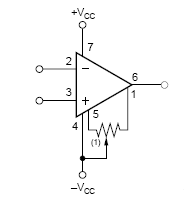
Contents
Null terminals
Some opamps include a pair of terminals which allow the user to compensate for the input offset voltage
at a given temperature and common mode voltage. The offset
voltage may be just the opamp voltage offset, or it may include other
system offsets, as the adjustment span is usually larger than necessary
to compensate for just the device offset. To use the null
terminals, a trim pot should be connected between the two terminals,
with the wiper terminal connected to the positive or negative supply.
The diagram shows the circuit for an opamp with null terminals on pins 1 and 5, which are connected to the negative supply.

The chooser application uses an 'n' prefix for null terminals which
should be connected to the negative supply and a 'p' prefix for null
terminals which should be connected to the positive supply. The
subsequent numbers are the pin numbers. As an example, 'n15' means that
the trim pot connects to pins 1 and 5, and the wiper goes to the
negative supply. Similarly, 'p213' means that the trim pot connects to
pins 2 and 13, and the wiper goes to the positive supply.
Check the device datasheet for exact details on recommended trim pot
values. Datasheets don't always give the available adjusment range, and
rarely indicate the polarity of the adjustment. In general, only
single devices have null terminals.
Null terminals can sometimes be used for other purposes. They have
comparable sensitivity to the input pins, which means that they must be
treated with care. They do however have a relatively low impedance and
a negligible common mode voltage range.

